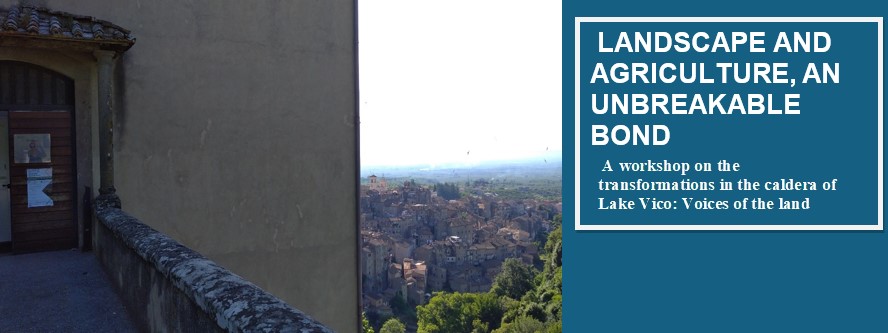A WORKSHOP ON THE TRANSFORMATIONS IN THE CALDERA OF LAKE VICO: VOICES OF THE LAND
On May 26, 2025, a workshop “Landscape and Agriculture: An Indissoluble Bond” was held at the Scuderie of Palazzo Farnese in Caprarola, Italy. This important event took place within the framework of the EUROLakes series of workshops, organized as part of the European project and promoted by the University of Tuscia (UNITUS). It provided an opportunity for an interdisciplinary discussion among experts from the academic world, public institutions, operators in the agricultural sector and local actors, to reflect on the relationship between agriculture and landscape, and discuss concrete solutions for the sustainable management of the Lake Vico basin territory – an area of great environmental and landscape value.
The main objective of this meeting was to analyze and enhance the landscape changes that have occurred in the Lake Vico caldera, a volcanic basin of high natural and agricultural value. Through several technical talks and local testimonies, it was highlighted how agriculture has played a central role in shaping the landscape of the area, contributing over time not only to its physical configuration but also to its cultural and socioeconomic identity.
It was shown how land use has changed over the decades from mixed and fragmented agriculture to gradual specialization, with the extension of hazelnut and chestnut cultivation. These changes have left a visible imprint on the landscape, creating an
agrarian mosaic that, although transformed, still retains historical and traditional elements.
During the workshop, the positive value of agricultural activity was stressed, both in terms of land preservation and as a tool for environmental conservation, when managed with sustainability criteria. In fact, agriculture was recognized not as a threat but as an ally of the landscape, capable of offering concrete solutions to environmental problems, such as soil erosion, through targeted agronomic practices, grassing and care for the hydraulic network.
The meeting also provided an opportunity to consider how agriculture can be rethought to be multifunctional, with production, environmental protection and local development closely interconnected, in the face of climate change and social transformation.
During the meeting, special emphasis was placed on sharing best practices, adopting Nature-Based Solutions (NBS) for soil erosion control, the need for co-designing land management strategies, and enhancing the central role of farmers in protecting the rural landscape.
The workshop was attended by more than 20 people, including:
- Prof. Nicoletta Ripa, coordinator of the UNITUS Unit of the EUROLakes project.
- Prof. Saverio Senni, moderator of the meeting.
- Eugenio Stelliferi, deputy mayor of Caprarola.
- Sebastiano Raimondo and Federico Cornacchia, from Fondazione Eni Enrico Mattei (FEEM), project partners.
- Technicians from the Lake Vico Nature Reserve (Giuseppe Puddu and Andrea Sasso).
- Luigi Dell’Anna, representing the environmental sector of Lazio Region.
- Agronomists from local cooperatives CPN (Cooperativa Produttori di Nocciole) and Assofrutti.
- About 4-5 local farmers, who brought valuable accounts of direct experience and critical issues experienced daily in the field.
The event was also an important step toward building a local community of practice, with the active involvement of key stakeholders, in a participatory, shared and long-term oriented perspective.
Lake Vico: Agriculture, Landscape, and the Future of the Caldera
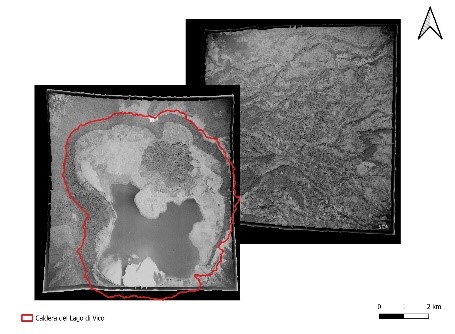
The event offered a comprehensive look at how the landscape around Lake Vico has changed over the past 70 years, with agriculture playing a central role. Through aerial photo analysis and photointerpretation of images from 1954, 1971, and to date, Dr. Giulia Mancini presented a detailed and quantitative reconstruction of land-use transformations. Her findings focused on the spread of hazelnut cultivation, now one of the dominant land uses in the area.
Yet, she noted that these changes, though significant, should not be viewed as inherently negative:
“The transformations in the caldera of the lake have been numerous, but not necessarily negative —especially from a landscape point of view. Other developments, such as urban sprawl, could have occurred instead.”
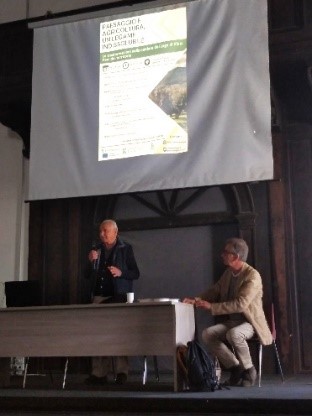
The day continued with personal and technical insights from key local figures. Arcangelo Giorgi, a long-time farmer, shared firsthand experiences of agricultural shifts from the 1930’s to nowadays, and the adopted solutions to past issues and currently perceived hazards (e.g., wild fauna-human conflicts). A representative from the CPN cooperative, the agronomist Gianluca Santinelli,described the organization’s work supporting local growers, including efforts to promote sustainable practices and implement ecological initiatives.
Attention then turned to future land-use scenarios. Dr. Raffaele Pelorosso presented several plausible alternative futures – such as forestation, urbanization, and different crop typologies, discussing their landscape, environmental, economic and social impacts.The day continued with personal and technical insights from key local figures. Attention then turned to future land-use scenarios. Dr. Raffaele Pelorosso presented several plausible alternative futures – such as forestation, urbanization, and different crop typologies, discussing their landscape, environmental, economic and social impacts.
The final talk, led by Dr. Chiara Iavarone, focused on EUROLakes and its innovative approach to lake landscape governance. It highlighted the participatory approach of EUROLakes through the creation of a “community of practice” – a collaborative group of shared interests that can discuss and address challenges related to land management and landscape preservation.
Lastly, the workshop addressed the issue of soil erosion, particularly in steep areas, and types of practices that can be used to resolve this issue. Several Nature-Based Solutions (NBS) were discussed, including:
- Retention basins and vegetative buffer zones to reduce the dispersion of nutrients and agrochemicals, as well as limit the problems linked to erosion.
- Managed grass cover with delayed mowing to protect soil and support biodiversity
- Dry-stone walls or gabions to slow water runoff and maintain soil fertility
- Drainage channels along field boundaries to improve stormwater management, especially under current climate change-driven precipitation patterns
These strategies highlight the potential for sustainable interventions that balance agricultural productivity with environmental conservation.
Roundtable and road ahead
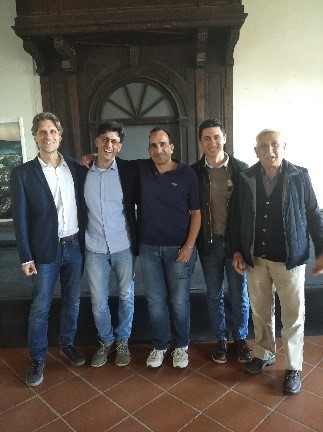
The discussion stemming from the roundtable revealed that the landscape of Lake Vico is a product of agriculture, while its current state reflects decades of agronomic choices. Recognizing the positive role of farmers is crucial. This does not mean becoming complacent and practicing unsustainable agriculture; rather, we must pursue good agronomic practices and sustainable methods to encourage and support the preservation of the land and the consequent preservation of agricultural activities.
We understood that one of the most pressing issues is the erosion phenomenon affecting farmland, despite good practices being in place for soil fertility conservation. Coordinated interventions and technical support are needed to prevent or limit this phenomenon, like a system of drainage channels or vegetable strips. Moreover, best practices, such as the proposed Nature-Based Solutions and the adoption of integrated pest and disease management, need to be promoted, extended to all farmers, regulated, and effectively communicated to the general public.
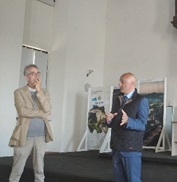
The direct involvement of local stakeholders is essential, and tools such as communities of practice can facilitate this process by bringing together all the stakeholders surrounding the lakes — not only farmers, but also tour operators, environmentalists, citizens, and regional or provincial institutions and associations. Farmers also expressed a clear willingness to embrace innovation, both in agricultural practices and in the adoption of new systems and technologies.
Innovation and tradition can go hand in hand: introducing new hazelnut varieties, specialized equipment, and sustainable techniques will require a solid network of collaboration between researchers, cooperatives and the farming community.
It is also essential to broaden the dialogue to other sectors, such as tourism and local restaurants, for a truly integrated enhancement of the area.
So, what’s next?
The journey continues with follow-on meetings, concrete proposals and a shared goal: building a resilient, thriving future for Lake Vico and its surrounding communities.
The key takeaways from the workshop are in particular: Increased institutional involvement, the importance of public agencies playing a more active role was stressed, as they can act as a stable intermediary between the project and the agricultural world; Direct contact with stakeholders, some participants suggested making targeted contact with key figures in the area and taking advantage of existing networks among those who attended the meeting; New venue for future meetings, the Municipality of Caprarola has offered a room to host future meetings, which will facilitate logistics and promote continuity of dialogue.
The workshop concluded with an invitation to participants to join the Community of Practice promoted by the project. An approach designed to build a participatory, shared and lasting approach to land management.
Ultimately, the aim is soon to expand to include other strategic sectors, such as tourism, environmental associations and institutions, and local restaurants. The goal is to establish a comprehensive and integrated network of stakeholders dedicated to maintaining and improving the environmental status of Lake Vico while preserving local identities.
Contributor: UNITUS


